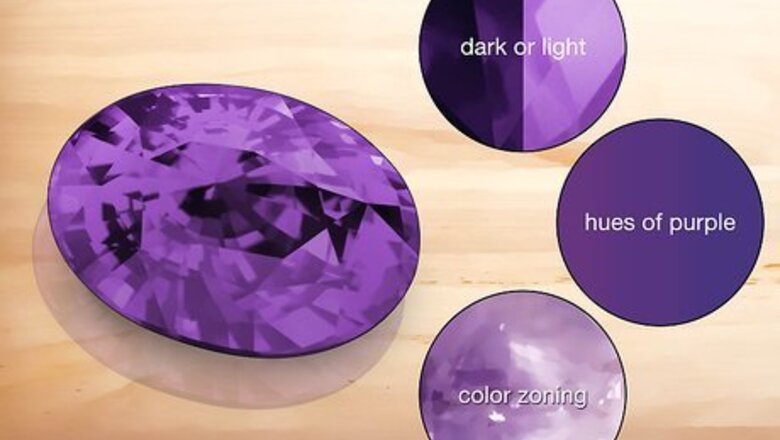
views
Examining the Gem
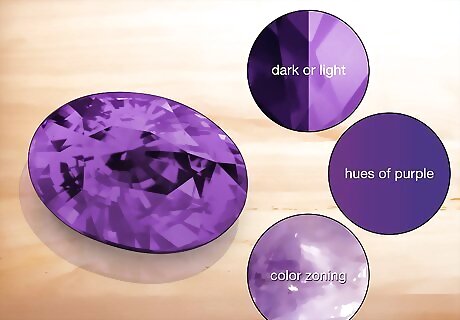
Check the color. Amethyst is a purple or violet shade. Some gems may have a slightly reddish undertone, but should still remain primarily purple. Brightness varies. Some amethyst gems may be so light there is only a light purple glimmer. Some may be so dark that, under light, they appear blackish. Color will not be entirely consistent in authentic amethyst. Your gem should have different hues of purple throughout and color may change slightly in response to different lighting. Color zoning is the uneven distribution of color in a gemstone. This may occur in amethyst gems. Authentic amethyst may have some color zoning, which can lessen its value, that's typically visible when the gem is laid flat on a white surface.
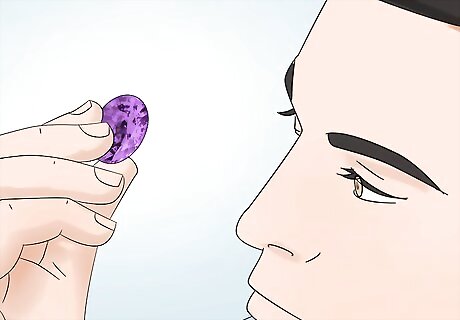
Look at the gem's clarity. Clarity can also help clue you in as to whether an amethyst gem is authentic. Amethyst is generally eye-clean. This is a term that means the product is free of inclusions, which are materials trapped in a gem during its formation, visible with the naked eye. An authentic amethyst is likely to be mostly clear in appearance. Bubbles and discolorations are unlikely.
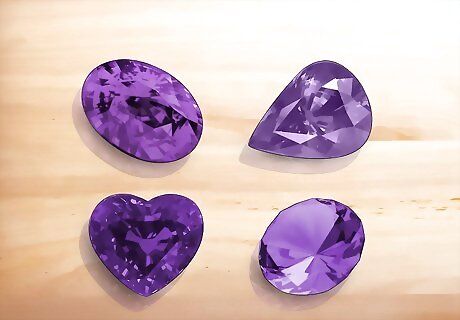
Examine the cut. Amethyst is easy to cut, so it's not uncommon to find amethyst jewelry in a wide-variety of shapes and sizes. You may find genuine amethyst cut into round shapes, pear shapes, squares, hearts, and so on. As amethyst cuts easily, authentic amethyst should be smooth and polished upon purchase. If the amethyst in question is cut into a round shape, look for uneven distribution of color. If there seems to be a lot of color variation, this actually means the stone is more likely to be authentic. Jewelers frequently cut discolored amethyst into a round shape as this makes variations slightly less noticeable.
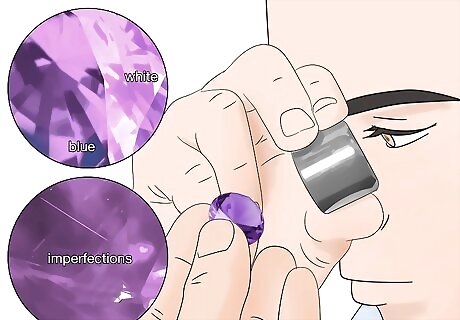
Look for imperfections or inconsistencies. Authentic gems should be slightly imperfect. There should be some color zoning and the shade should have tones of white or blue in addition to purple. A gem that is one particular shade of purple throughout is likely a fake. You should also look for things like bubbles and cracks within the amethyst. A real gem will have some slight wear or tear accrued over time. Examine your amethyst closely for inconsistencies. Authentic amethyst is more valuable if cut and manipulated in a way to minimize the appearance of things like color zoning and scratches. Therefore, it may take quite a bit of examination before you notice any imperfections. Examine the gem under a magnifying glass if necessary.
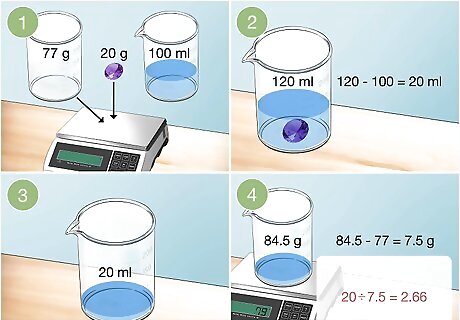
Test the gem's specific gravity. Specific gravity is a term used by jeweler's to ascertain the rough density of a gem. For amethyst, specific gravity should be around 2.65. You can measure specific gravity with a beaker, big enough to fit your piece of amethyst in, and a scale. To start, write down the weight of the beaker. Then, write down the weight of the amethyst. Then, partially fill the beaker with water and write down the amount of water, as measured by the beaker. Put the amethyst into the beaker. The water should rise. Subtract the level the water is at now from its original level. Write this number down. This is the amount of displaced water. Remove the amethyst and drain the water. Put in the amount of water that the mineral displaced. Weigh the beaker again, with the displaced water in it. Subtract the beaker's original weight from this number. This is the weight of the displaced water. To find specific gravity, divide the weight of the amethyst by the weight of the displaced water. This numbers should be somewhere in the 2.65 range if you have real amethyst.
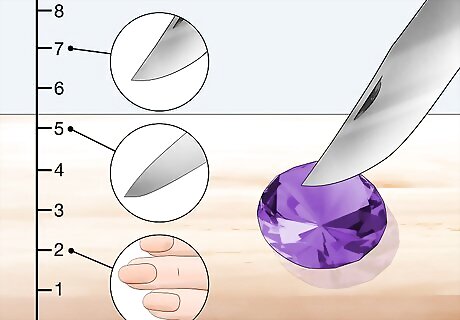
Test your gem's hardness. The hardness of a gem is measured on a scale from 1 to 10. Amethyst is a 7, meaning it's a fairly hard gem. Testing the hardness of a gem is a somewhat inexact process. However, you can test the hardness of a gem by seeing if its scratch resistant to other gems. If your amethyst is authentic, it should be scratch resistant to anything that falls lower than 7 on the hardness scale. Everyday objects fall fairly low on the hardness scale. A fingernail is has a hardness of 2. A knife blade is a 5. A steel blade is a 6.5. Try to gently scratch your amethyst with your finger nail or a knife blade. You can scratch it against an object with a steel blade, like an expensive knife or axe, if you can find one. Your amethyst should be scratch resistant to these objects. If it is not, it may not be authentic. Learn to spot authentic gems online. "I like buying stones online, but it's so easy to get tricked if you don't know what to look for. This article had super helpful tips on how to tell if an online seller is legit. Stuff like checking for lab reports, reading reviews, and watching for odd gem names will help me avoid fakes and confidently buy real amethyst." - Jacqueline J. Apply techniques from a dubious source. "As someone who makes fake amethyst to sell as real, I have some great pointers here! The detailed info on things like color, clarity, cut, and hardness will really help me make my synthetics look more real. While I don't love passing off fakes, these tips will seriously improve my craft." - Kyle S. Gain knowledge to avoid scams. "I'm totally new to gemstones, but I love collecting them. Over the years, I've been duped a few times by shifty online sellers passing off glass as amethyst. This article explained just how to test color, scratches, density, and all that to avoid getting tricked again. Now, I can buy stones online with the smarts to catch fakes." - Jeanne B. Verify the authenticity of a treasured piece. "I had this ring gifted to me as amethyst, but I wasn't sure if it was real. After reading through the steps here, I did a simple scratch test with a knife. When it didn't leave any marks, I realized this was the real deal! Now I can treasure it, knowing for sure it's a legit gem." - Rosalie W. We want to hear from you! Advice from our readers makes our articles better. If you have a story you’d like to share, tell us here.
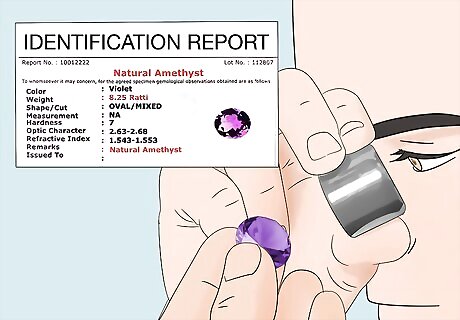
Consider professional testing. The only way to be completely sure of the authenticity of amethyst is to have it tested. You can take your amethyst to a local jeweler and ask him or her about lab identification. Cost varies depending on the size of your gem. If you're concerned about authenticity, it may be worth the cost to know for sure. Professional testing can ascertain whether an amethyst came from a geode. Many amethysts originally came from geodes.
Considering the Vendor

Find a reputable gem dealer. If you want to make sure you're amethyst is real, look for a solid dealer. You're less likely to find knock off amethyst if you work with a dealer with a solid reputation. Ask friends who are into jewelry. This is the easiest place to start when seeking out a gem dealer. If you have friends that have a lot of expensive jewelry, ask them where they got their best pieces. They may be able to point you to a solid dealer. The American Gem Trade Association, the Federal Trade Commission, and the Jeweler's Vigilance Committee are organizations that all work to ensure honestly and quality when it comes to gem dealing. If a jeweler is affiliated with one of these organizations, he or she is more likely to be legitimate. If a gem comes with a lab report, which should verify things like specific gravity and hardness, it's far more likely to be authentic. Buy from dealers who provide lab reports with their gems.

Ask about the gem's origin. A reputable dealer should not shy away from answering questions about his products. Ask where the amethyst comes from. If the dealer hesitates, this is a bad sign. A good dealer should be knowledgeable about the origin of his products. Amethyst is typically found in Brazil, South Africa, and Namibia. In the US, it's often found in Arizona, Colorado, and the Carolinas. It's also found in parts of Canada. If a gem does not come from one of the above places, that does not necessarily mean it's inauthentic. Amethyst is present across the world. However, request a lab report if the amethyst is from an unusual region.
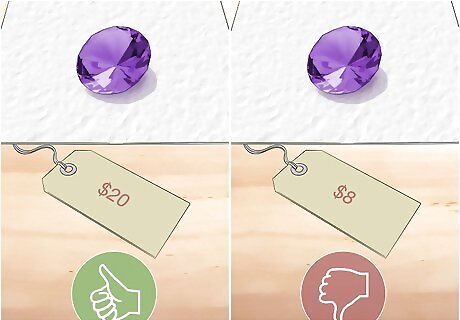
Consider the price. Amethyst is generally inexpensive. It's not uncommon to find amethyst jewelry for around $20. You should be suspicious of amethyst sold cheaper than this. Many vendors may market fake amethyst as authentic and then sell it well below market value. This is to trick consumers into thinking they're getting a deal. Follow the old adage, "If it seems too good to be true, it probably is." Stay away from low price gemstone.
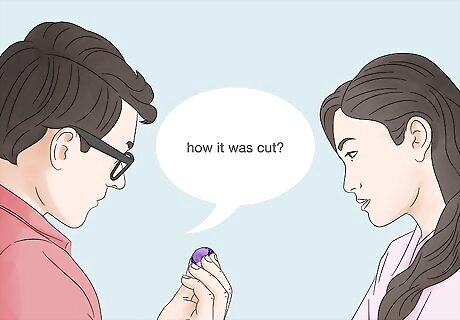
Ask for information during the sale. When buying amethyst, ask for information about where the gem was mined, how it was cut, and so on. If a jeweler is able to answer these questions with ease, his product is more likely to be authentic. If he seems hesitant to provide too much information, he may be hiding something. It might be a good idea to seek out another seller.
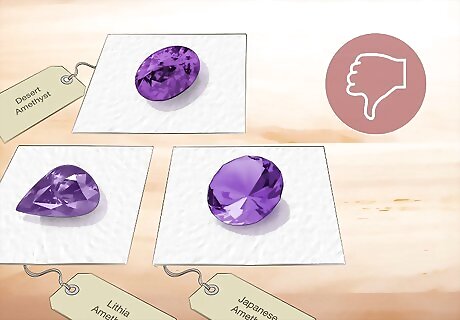
Be wary of unusual names. Many stores mislabel synthetic stones or low-quality purple sapphire as special forms of amethyst. They may be marked as Japanese Amethyst, Desert Amethyst, Lithia Amethyst, or Bengal Amethyst. Be distrustful of such designations. These stones are likely fake.

Look for legitimate online dealers. It's not recommended that you purchase gems online. Fraud is far more likely over the internet. However, if you choose to go the online route, go for a site that seems legitimate. The dealer should be affiliated with some of the organizations listed above. He or she should also have a company name, phone number, and physical address. Check to make sure the business is active. New content should be added regularly. There should be information about how much of a given product is in stock. Read any reviews you can find. If a lot of customers had a problem with a given store, it may have a bad reputation for a reason. You should also not buy amethyst online if there's no return policy.














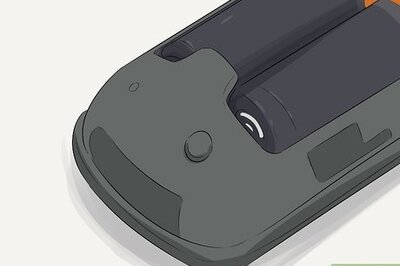




Comments
0 comment